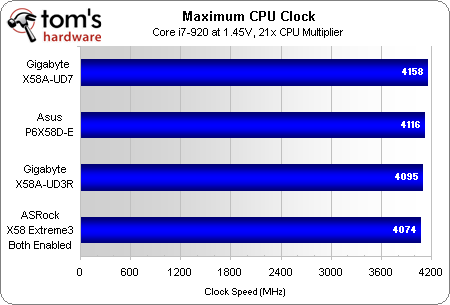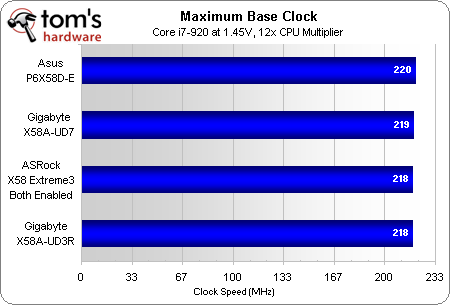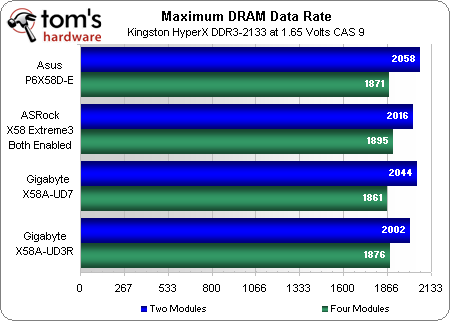X58 In 2010: Four LGA 1366 Boards With USB 3.0 And SATA 6Gb/s
The March 2010 launch of Intel's hexa-core Core i7-980X gave us a good reason to revisit the LGA 1366 interface. Today, we're looking at four new X58 Express-based motherboards that tie USB 3.0 and SATA 6Gb/s support in to Intel's flagship platform.
Overclocking
Here’s a quick comparison chart of the available BIOS settings each motherboard provides to assist overclocking and related performance optimizations.
| BIOS Frequency and Voltage settings (for overclocking) | ||||
|---|---|---|---|---|
| Row 0 - Cell 0 | ASRock X58 Extreme3 | Asus P6X58D-E | Gigabyte X58A-UD3R | Gigabyte X58A-UD7 |
| CPU Base Clock | 100-300 MHz (1 MHz) | 100-500 MHz (1 MHz) | 100-600 MHz (1MHz) | 100-600 MHz (1MHz) |
| CPU Multiplier | Yes | Yes | Yes | Yes |
| DRAM Data Rates | BCLK x6-x16 (x2) | BCLK x6-x18 (x2) | BCLK x6-x18 (x2) | BCLK x6-x18 (x2) |
| PCIe Clock | 50-150 MHz (1 MHz) | 100-200 MHz (1MHz) | 90-150 MHz (1MHz) | 90-150 MHz (1MHz) |
| CPU Vcore | 0.84-2.00V (6.25mV) | 0.85-2.10V (6.25mV) | 0.50-1.90V (6.25mV) | 0.50-1.90V (6.25mV) |
| Uncore Voltage | 1.20-1.90 (70mV) | 1.20-1.90V (6.25mV) | 1.075-2.015V (20mV) | 1.075-2.015V (20mV) |
| IOH Voltage | 1.11-1.49V (6.25mV) | 1.10-1.70V (20mV) | 1.00-2.00V (20mV) | 1.10-2.00V (20mV) |
| ICH Voltage | 1.16-1.56V (20mV) | 1.10-1.40V (100mV) | 0.92-2.38V (20mV) | 0.92-2.38V (20mV) |
| DRAM Voltage | 0.96-2.00V (15mV) | 1.20-2.46V (20mV) | 1.30-2.60V (20mV) | 1.30-2.60V (20mV) |
| CAS Latency | 6-11 Cycles | 3-11 Cycles | 5-15 Cycles | 5-15 Cycles |
| tRCD | 3-15 Cycles | 3-15 Cycles | 1-15 Cycles | 1-15 Cycles |
| tRP | 3-15 Cycles | 3-15 Cycles | 1-15 Cycles | 1-15 Cycles |
| tRAS | 9-31 Cycles | 3-31 Cycles | 1-31 Cycles | 1-31 Cycles |
Though some boards have broader adjustments than others, we normally reach the limits of our hardware at BIOS settings far below the maximum. Part of that is due to a very early C0 stepping CPU core that we’ve used consistently to provide comparable overclocking data for all of our X58 motherboard roundups.
The motherboards with 16-phase and 24-phase CPU power regulators push our old CPU beyond 4.1 GHz, while those with eight-phase units settle under that mark.
Asus takes the lead in maximum base clock by a mere 1 MHz. Both $200 motherboards reach the same speed, but ASRock takes the lead alphabetically.
Asus also takes the lead in memory speed. Greater numbers might have been achieved using Gulftown’s improved memory controller.
Get Tom's Hardware's best news and in-depth reviews, straight to your inbox.
Current page: Overclocking
Prev Page Benchmark Results: Synthetic Next Page Power, Heat, and Efficiency


